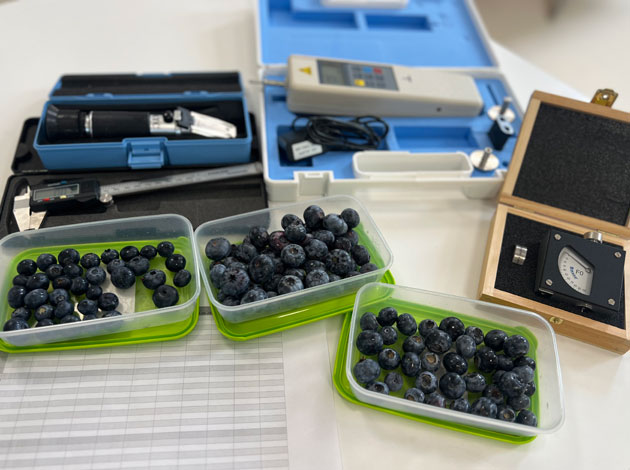Our nursery specializes in commercial production of highbush blueberry since 2000 when we have started collecting a stock of varieties for breeding purposes. At the same time we started breeding program for rhododendrons – our second branch of our production.
The experience gained on rhododendron breeding and the base of collected blueberry varieties allowed us to start in 2010 the breeding program of highbush blueberries. However, developing breeding know-how for this species would not be possible without cooperation with the Institute in Skierniewice. Especially, we would like to thank prof. Stanislaw Pluta for giving invaluable tips!
The progress of breeding work:
| Year | Breeding program phase |
| 2010 | Selection of parent plants and first controlled crossings being performed, followed by fruit gathering, extraction and sawing seeds. |
| 2011 | Seeds germination and growth of seedlings of F1 generation in trays with substrate. |
| 2012 | Growth of seedlings in M40 trays. |
| 2013 | Initial negative selection of seedlings that was based on morphological features, growth strength and potential for future growth in 2.5l and 5l containers. |
| 2014 | Second selection and planting the seedlings into the breeding-test field of around 1ha. |
| 2015-2018 | Growth of seedlings in the field and initial estimation of morphological features (growth, habit), blooming and flowering potential as well as fruit quality (size, taste, wax coating). |
| 2018 | Evaluation and selection of interesting seedlings – I round (19 genotypes selected). |
| 2019 | Evaluation and selection of interesting seedlings – II round (57 genotypes selected). |
| 2018 | Vegetative breeding (cuttings) of genotypes (clones) selected during I round. |
| 2019 | Vegetative breeding (cuttings) of genotypes (clones) selected during II round. |
| 2018-2022 | Growth of plants in the nursery |
| 2022 | Planting of 19 seedlings from I breeding round onto the test field for further observation and selection on larger number of plants. |
| 2023 | Evaluation of fructification and fruit quality that included measurements of mass, size, firmness, etc. |
| Selection of 6 most promising genotypes | |
| 2024 | Publication of obtained results along with development of test plan for fruit quality, final selection and commercial names. |
| 2024 | Registering selected genotypes at Research Center for Cultivar Testing (COBORU) in order to gain exclusive rights to new, registered varieties. |
| 2024 | Ongoing planting and selection of genotypes from following breeding rounds. |
The final selection is planned for 2024, when the selected, best blueberry genotypes will receive commercial names. They will be named after Greek mythological gods, hence the name of the entire series – Olympic Blueberries.
Only northern varieties, with high frost resistance took part in the breeding process. The goal was to obtain varieties with large and firm fruits, with emphasis on early and very early ripening varieties. The parameters that were the most important in the selection were: size, hardness/firmness, yield, shelf-life, BRIX, plant vigour and health.
The breeding program included:
- over 300 crossings made
- almost 20,000 seedlings were obtained for selection
- 19 initially selected seedlings were obtained from the first pollinations
- 57 seedlings obtained from later pollinations
- Micro seedlings were made from the selected genotypes
- observations and tests of fruit (BRIX, hardness, firmness, weight, diameter, shelf-life) were performed on a larger number (10 plants) of bushes from a given genotype
- another selection was made and the 6 most promising seedlings were selected.
The plants will be available for sale in autumn 2025 in a C2.5L container.









